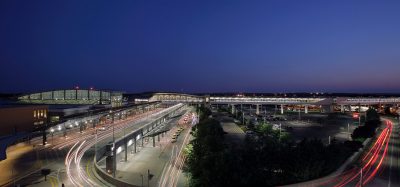World class environmental management
Posted: 30 May 2008 | Janell Barrilleaux, Director of Environmental Programmes, Denver International Airport | No comments yet
Located on 53 square miles of prairie land northeast of Denver, Denver International Airport (DEN) is a unique place in a unique setting, facing both environmental challenges and opportunities. Owned by the City of Denver, DEN is the newest major airport in the United States. The airport has been recognised as a state-of-the-art facility and a leader in environmental protection.
Located on 53 square miles of prairie land northeast of Denver, Denver International Airport (DEN) is a unique place in a unique setting, facing both environmental challenges and opportunities. Owned by the City of Denver, DEN is the newest major airport in the United States. The airport has been recognised as a state-of-the-art facility and a leader in environmental protection.
The environment was clearly a prominent consideration during the design and construction of the airport. This is evidenced by the underground fuel hydrant system, sophisticated leak-detection system for the fuel distribution network, designated aircraft deicing pads, on-site glycol-recycling plant, cardboard compactor rooms, and a dedicated industrial stormwater collection, conveyance, storage, and discharge system, to name just a few.
But even though DEN was a demonstrated leader with its design standards, the airport was not content to depend on its infrastructure to protect the environment. DEN’s management decided that in addition to being a state-of-the-art facility, the airport should be proactive and aggressive in developing a world-class environmental-management plan. With that goal in mind, DEN set out to create and implement a facility-wide Environmental Management System (EMS).
Simply defined, an EMS is a systematic approach to managing those aspects of a facility that have the potential to harm the environment. Through a cycle of plan, do, check, review’, the EMS provides a framework for a facility to proactively and systematically manage its environmental programmes.
DEN began developing its EMS in 2001, prompted mainly by the need to clearly define applicable environmental requirements; to determine roles, responsibilities, and accountabilities for environmental-compliance activities, and to develop internal and external auditing and inspection programmes. Airports are complex facilities that are regulated by various federal, state, and local agencies. A clear understanding of the various regulatory jurisdictions and requirements is critical to demonstrating compliance. Denver International Airport’s EMS provides a mechanism to make regulatory requirements clear and relevant to the significant environmental aspect of an airport’s operations.
The culmination of DEN’s environmental planning effort came in May 2004, when the airport’s EMS received ISO 14001 certification – the international standard for EMS’s. DEN is believed to be the first commercial-service airport in the United States to receive ISO certification for an EMS that encompasses the entire facility. To maintain its certification, DEN is audited semiannually by a third-party registrar who independently verifies the EMS’s conformance to the ISO standard. DEN’s EMS was originally certified to the 1996 standard and, in 2006, was subsequently certified to the newer, more stringent 2004 standard. DEN is in its second three-year certification cycle.
As a result of DEN’s efforts and ISO certification programme, the airport was accepted into the Colorado Department of Public Health and Environment’s (CDPHE) Environmental Leadership Programme as a Gold Leader in 2004. DEN then became the first airport in the United States to be accepted into the U.S. Environmental Protection Agency’s (EPA) National Environmental Performance Track Programme (2006). Both of these programmes are available only to those facilities with outstanding environmental-compliance records and which have an EMS in place. DEN continues to garner recognition for its environmental excellence, being named recipient of the Federal Aviation Administration Denver Airports District Office Award (2008), the Metro Wastewater Reclamation District Gold Award and the City of Denver 5281 Award (both in 2007), and the CDPHE Pollution Prevention Award (2006).
One of the key components in an ISO 14001-certified EMS is to define continual improvement goals or objectives, and to develop programmes and activities to achieve those objectives. DEN’s EMS includes five specific objectives:
- Improve environmental compliance
- Reduce potential environmental liabilities
- Enhance the airport’s positive image
- Implement a reliable EMS
- Evaluate pollution-prevention, energy-conservation, and waste-minimisation opportunities.
Every year, DEN establishes specific targets under each of these objectives, and these targets are tracked and evaluated for performance. Under the pollution-prevention, energy-conservation, and waste-minimisation objective, DEN identified specific five-year targets for each of the following:
- Transportation energy use by fuel type: Decrease by 1% the gallons of gasoline used per vehicle per year.
- Non-transportation energy use: Decrease by 1% the annual kilowatt hours (kWh) used per passenger.
- Non-hazardous solid waste generation: Decrease by 5% annually the pounds of solid waste disposed of per passenger.
- Hazardous waste generation: Decrease by 1% annually the amount of city-generated hazardous waste.
- Discharges to water: Strive to maintain an aircraft deicing fluid collection efficiency of 69%.
Baseline numbers were established in 2005 and the targets were projected as far as 2010. DEN’s performance toward these targets is stated both internally and externally in the airport’s annual environmental reports, as well as to CDPHE as part of the Environmental Leadership Programme, and to the EPA under its National Environmental Performance Track programme.
As evidenced by its EMS, DEN is clearly committed to incorporating sustainability principles into its everyday activities. Denver Mayor, John Hickenlooper, shared his vision for a sustainable Denver in 2004, by committing to the development of a sustainability plan for the city. Greenprint Denver, which was published in 2006, serves as the city’s environmental-action agenda. The plan, which has been augmented by the Denver Climate Action Plan, sets aggressive goals in the areas of energy and water conservation, materials and waste management, emissions reductions, and water-quality improvements. Through the implementation of its well-established proactive environmental programmes, DEN continues to improve its overall performance in its core regulatory programmes, as well as making strides in achieving the mayor’s goals for a sustainable Denver.
Since DEN implemented its EMS, it has completed several projects that have provided tangible environmental benefits. In many instances, these projects have also lowered operating costs, which is an excellent indicator of a truly sustainable project. DEN continues to look for these types of opportunities that demonstrate environmental, economic, and/or social benefits. A few of the projects DEN has completed, or which are currently underway include:
- Solid waste recycling – DEN made numerous improvements to its recycling programme. These include the addition of recycling containers for aluminum cans and plastic bottles in public areas; recycling of glass containers from bars and restaurants, and education and outreach programmes to improve tenant and concessionaire participation in the programme. DEN increased its diversion rate from 4.4 % to 7.3% between 2005 and 2007, which reduced hauling and disposal costs and increased the revenue generation from commodity sales from $27,000 to nearly $85,000.
- Deicing fluid management – Improvements to the aircraft deicing fluid collection, storage, and recycling system have been significant over the last few years. In the 2006/2007 deicing season, over 1.8 million gallons of aircraft deicing fluid were applied at DEN. Over 853,000 gallons (or 46%) of applied fluid was reclaimed, which is among the highest reclamation rates in the country. Without a recycling plant to reclaim this fluid, DEN would have spent over $1.8m to send the fluid to the sewage-treatment system.
- Solar photovoltaic project – In 2008, ground was broken for a 2-megawatt solar installation on DEN property. Consisting of over 9,800 panels on 7.5 acres of ground, the system is estimated to provide 3.5 million kilowatt hours of electricity, and will result in the elimination of over 5 million pounds of carbon dioxide emissions annually. The solar project is planned for completion in the third quarter of 2008.
- Alternatively fueled vehicles – Denver has been a national leader in the ‘Green Fleets’ movement since it enacted the first ‘Green Fleets’ executive order in 1993. DEN’s fleet of vehicles includes; vehicles powered by compressed natural gas, hybrid technology, and biodiesel fuel. The percentage of alternatively fueled vehicles in DEN’s fleet has continued to rise over the years, and is currently at 28.5%.
- Hazardous waste reduction – In the last five years, improvements in maintenance operating practices and purchasing procedures have resulted in more than a tenfold reduction in hazardous waste generation, from 15,700 pounds in 2002 to 1,405 pounds in 2007. Recycling of universal waste, consisting mostly of electronics (computers, monitors, etc.) and fluorescent light bulbs, has become routine and comprehensive for city-generated universal waste. In 2007, this resulted in the recycling of over 26,000 pounds of electronics and 3,144 light bulbs.
- Access fee reduction programme – Hybrid taxis are becoming increasingly common with taxicab companies in the metropolitan Denver area. To promote and encourage this development, DEN has instituted a programme to reduce access fees for hybrid taxis by 10%.
- Carpool programme – DEN employees who form carpool teams are eligible for incentives, including access to close-in parking spots. This programme began in January of 2008.
As part of Denver International Airport’s goal of continuously improving its EMS, several new initiatives are planned or underway this year. They include:
- Master energy study – conducted by an expert energy consultant, the results of this study should provide a number of recommended projects and actions to significantly reduce energy consumption at DEN.
- Waste composition study – in order to find areas for improving DEN’s solid waste and recycling programme, including increased diversion of recyclables from solid waste disposal, a study is being conducted to determine the contents and to generate locations for solid waste.
- Organics recycling – one element of the waste-composition study will be an in-depth analysis of the organic component of the solid waste stream, in order to determine the feasibility of separate handling and removal of organics.
- Wind energy study – to examine the energy potential of installing wind turbines at some remote locations on DEN’s property.
- Carbon offset programme – a voluntary programme that will enable travellers to purchase third party-certified carbon offsets in order to reduce the greenhouse gas impacts of individual air travel activities.
- Sustainable design criteria manual – an internal manual with standards and guidelines on how sustainable buildings and infrastructure should be constructed, as an aid to DEN’s airport planners.
- Expand recycling to parking lots and garages – provide sufficient containers and staff support for a comprehensive recycling effort at these underserved areas.
For more information, visit www.flydenver.com/diabiz/environmental.
It is apparent that from the initial development of Denver International Airport’s EMS, and through its continued support and growth, many benefits have been realised. The rewards are seen not only in reduced fines and violations, but in positive environmental, social, and economic terms. In fact, recent insurance quotes indicate that the benefit of having a robust and dynamic EMS saves DEN $150,000 in annual insurance premiums. Attention and effort have moved away from strict regulatory compliance concerns toward a broader approach, that encompasses sustainability principles, and this philosophy has gradually taken hold throughout the organisation. DEN’s employees, business partners, and community stakeholders are all becoming increasingly aware of the positive benefits of looking at old problems in new and more sustainable ways. With that level of attention and focus on environmental concerns, the sky is the limit.
About Janell Barrilleaux
Janell Barrilleaux is the Director of Environmental Programs for the City and County of Denver, Department of Aviation. Her responsibilities not only include ensuring compliance with all environmental requirements for Denver International Airport, but she is also responsible for the remediation of the former Stapleton International Airport and leads the sustainability efforts at DIA. Prior to joining the airport, Ms. Barrilleaux spent 15 years in environmental consulting. Since joining the airport in December 2000, she has had to switch gears from remediation, to planning, permitting, and pollution prevention. Whether it’s securing air permits for the airport incinerator, or taking water quality measurements in stormwater drainages, Barrilleaux finds herself interacting with nearly every department at the airport on compliance and sustainability issues.
Are you ready to meet the expectations of Gen Z travellers? Join our virtual panel to discover how airports can engage the next generation of passengers.
16 Oct 2025 | 14:00 PM BST | FREE Virtual Panel Discussion
Join us for this interactive session where industry leaders will explore how airports are adapting to the needs and values of Gen Z, the first truly digital-native, socially conscious, and tech-savvy generation.
What You’ll Learn:
- What drives Gen Z travel decisions, and how to respond
- How to harness digital tools, social media, and mobile-first strategies
- How sustainability, inclusivity, and personalised experiences shape Gen Z’s airport expectations
- Real-world examples from leading airports that are successfully engaging younger travellers
Don’t miss your chance to learn from the airports leading this change – Register Now – It’s Free!

















